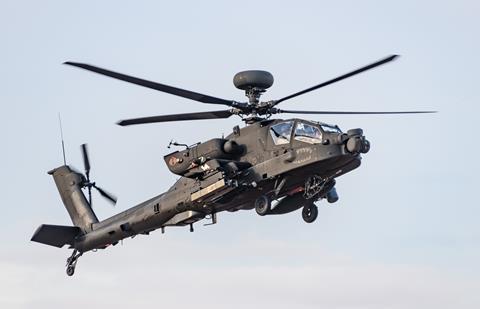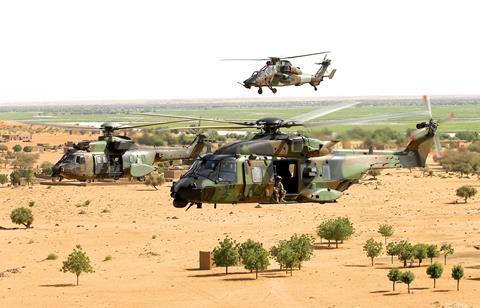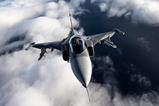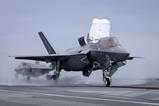The US Army’s surprise decision to terminate its ambitious Future Attack Reconnaissance Aircraft (FARA) programme put the brakes on an expected major shift in the military rotorcraft sector – and delivered a significant boost to Washington’s incumbent suppliers.
Reading between the lines of the service’s termination announcement, its leaders had become increasingly concerned about the poor survivability rate for combat helicopters during the war between the armed forces of Kyiv and Moscow.

“We are learning from the battlefield – especially in Ukraine,” army chief of staff General Randy George said as the FARA requirement was cancelled on 8 February. “Aerial reconnaissance has fundamentally changed. Sensors and weapons mounted on a variety of unmanned systems and in space are more ubiquitous, further reaching, and more inexpensive than ever before.”
Rather than continue to plough billions of dollars into the FARA project, the service instead has opted to “rebalance its aviation modernisation investments across new and enduring platforms”.
“Without re-prioritising funds in its constrained aviation portfolio, the army faced the unacceptable risk of decline and closure of production and sustainment lines for the [Boeing] Chinook and [Sikorsky] Black Hawk fleets,” the service says. “The new plan will renew and extend production of both aircraft, while also sustaining the experienced workforce and vendor base that underpin the army’s aviation capabilities.”
“To maintain strategic advantage means accelerating the pace of change,” the US Army’s director of aviation General Walter Rugen said at Defence IQ’s International Military Helicopter conference in London shortly after the announcement of FARA’s demise.
He also confirms that the lessons of the ongoing conflict in Ukraine “played very large” in the army’s reassessing its equipment needs.
“We must speed our transition from a counterinsurgency force to one postured for large-scale combat operations,” Rugen says. “We must invest in capabilities that will deter China and Russia in the near-term.
“This means difficult decisions need to be made in the Pentagon – and it has been difficult,” he says. “The competition for resources is as intense as it has ever been – maybe more so. With increasingly downward pressure being applied to top-line budgets each year and continued budget uncertainty, we simply cannot afford to build everything.”
CURRENT PROGRAMMES
As it was not involved in the FARA contest, the decision to shut down the armed scout need delivered a welcome boost for two of Boeing’s current-generation aircraft programmes. Using released funds, the army will make fresh investments in the AH-64E Apache attack helicopter and CH-47F Chinook Block II transport.
“The army is going to be flying Chinooks and Apaches into 2060,” notes Mark Bellew, Boeing’s senior director, business development, vertical lift programmes.

The service will continue fielding AH-64Es until fiscal year 2027/2028 under current plans, with production also taking place for new export customers Australia and Poland, who will take up to a combined 125 examples. “We are going to continue to build the aircraft through until the end of the decade,” says Bellew, who is confident that the company also will secure additional international sales for the type.
While a deal has yet to be concluded, the US Army will enter into an agreement with Boeing “with a path to full-rate production in the future” for its Block II-standard Chinook, which brings enhanced lift and extended-range performance.
Washington’s acquiring the latest version of the CH-47F in volume also represents good news for international buyers. Germany, for example, will see a financial benefit in its 60-aircraft Chinook buy, as it will be able to draw on unit cost savings enabled via a multi-year procurement by the larger customer.
“We are quite happy with the US Army decision [on FARA],” notes Colonel Christian Guntsch, advisor to the German air force chief for Berlin’s roughly €7 billion ($7.6 billion) CH-47F buy. Being acquired via the Foreign Military Sales mechanism to replace the European nation’s Sikorsky CH-53s, the rotorcraft will be delivered from 2027.
Sikorsky, meanwhile, can expect to enjoy several more years of success with its UH-60M Black Hawk platform, even though the army’s continuing Future Long Range Assault Aircraft (FLRAA) project will provide a successor for the type: Bell’s V-280 Valor tiltrotor. The service is due to continue receiving UH-60Ms through FY2026 currently.
LONG SERVICE
Jay Macklin, Sikorsky’s director, army FVL and innovations business development, notes that the US military will continue to fly UH-60-series aircraft until 2070.
The company is eyeing a potential need to update the type with features including a digital backbone using modular open systems architecture avionics, and fly-by-wire controls.
It also continues to advance work to enable the Black Hawk to perform autonomous missions, or to operate with enhanced safety by using what it describes as an “intelligent co-pilot”, which can warn about potential controlled flight into terrain.

The key elements within the army’s Future Vertical Lift (FVL) effort to transform its aviation fleet, both FLRAA and FARA sought to acquire breakthrough technologies, particular with regard to speed.
Bell was in December 2022 selected to produce the V-280, defeating a rival offer from a Sikorsky-Boeing team with the Defiant X. “FLRAA’s inherent reach and stand-off capabilities will ensure mission success through tactical manoeuvre at operational and strategic distances,” the army said of its selection.
For FARA especially, the army envisioned a platform that would capable of operating low and fast. Such traits would enable the service to keep its aircraft and personnel out of harm’s when facing advanced ground-based air-defence systems and man-portable weapons.
Yet to be flown, the FARA candidates – Bell’s 360 Invictus and Sikorsky’s Raider X – were designed to meet a performance requirement of at least 180kt (333km/h). Following a fly-off process, the selected type was to have delivered a capability to replace the army’s already retired Bell OH-58 Kiowa Warrior.
Instead, the service will continue to employ the Apache for such tasks, in concert with assets including a future tactical uncrewed aircraft system (FTUAS) and so-called air-launched effects (ALEs).
Still in its competitive phase, the FTUAS programme aims to deliver aircraft from FY2026. These will replace its Textron RQ-7B Shadow vehicles, with the current supplier and Griffon Aerospace in contention.
EXTENDED REACH
The service has already performed trials involving the Black Hawk deploying Anduril Industries’ Altius-600 UAS. Such a system could be employed as an ALE, extending platform reach by providing surveillance, electronic warfare capability or kinetic effect.
The army will later this year also begin fielding Rafael’s Spike NLOS long-range air-to-surface missile with its V6-standard AH-64Es. The weapon has a precision strike capability against fixed and moving targets from a maximum range of 27nm (50km).

“There are a lot of countries interested in the integration of Spike NLOS for Apache ‘Echo’,” Rafael says, pointing to lessons learned from the war in Ukraine. “Everybody is looking for stand-off [range], since the threat is much greater than it used to be.”
Questions remain around the complex task of managing airspace congestion and deconflicting assets in an era where manned rotorcraft will operate in the same battlespace – and in many cases at the same altitude – as multiple UAS and ALEs.
Meanwhile, pointing to the transformational future effect of the FLRAA platform, Rugen notes: “We will learn from our sister services when introducing a new and complex capability.”
Current plans call for the first army unit to be equipped with the V-280 during FY2031.
Notably, the FARA platform was to conduct a role that multiple other nations did not see a need for.
“As we fly very low altitude, high speed is not a priority – in fact, we question it,” a French army official says, noting that nap-of-the-earth operations – used to protect against detection and hostile fire – require aircraft to operate at slower speeds.

Paris will add extended-range weapons to its Airbus Helicopters Tiger attack helicopters as part of a future Block II+ update, and make efficiencies by replacing multiple aged platform types with the manufacturer’s H160M. The nation’s armed forces also are increasingly fielding unmanned systems.
Other speakers at the recent conference noted the importance of not drawing snap conclusions from the war in Ukraine – and especially regarding Russia’s poor performance using attack helicopters.
HEAVY LOSSES
Kyiv claims to have destroyed 310 Russian helicopters since Moscow’s forces invaded Ukraine in February 2022, although this total cannot be independently verified. Losses have included multiple examples of the Kamov Ka-52 and Mil Mi-28N.
“Ukrainian and Russian aviation capabilities – and tactics in particular – are different to NATO, so it is difficult to draw conclusions,” a British Army source notes. “Russian helicopters started [combat operations] by flying in daylight and at height. Their aircraft protection systems are outdated, and they have no mission management.
“Appropriate ‘shaping’ options are also required,” the official says, referring to the need for supporting ground forces, artillery, electronic warfare and cyber techniques to reduce the risk for helicopters as part of an operating package.
“We must draw the right lessons from the war in Ukraine,” the same source says. “Proliferation of air defence is not a new problem – we have been countering it for decades with our technology and our tactics. Vulnerability is a constant reality.”
As an example, the official points to Russian forces’ major helicopter assault on Hostomel airport near Kyiv in the opening hours of the conflict, which failed not due to rotorcraft losses, but because transport aircraft carrying supporting personnel and equipment failed to arrive.
“We should see [the assault on] Hostomel as a failure of planning, synchronisation and condition setting – not a general ruling on the applicability of combat aviation,” the official says.
Referring to future operations with a mix of manned, uncrewed and autonomous systems, the source notes: “By combining these different capabilities we can continue to deliver a competitive advantage.”
























